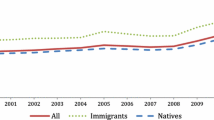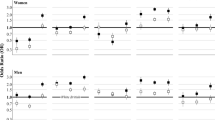Abstract
Immigrants living in the United States tend to exhibit racially stratified outcomes, with greater socioeconomic disadvantage experienced by immigrants of color. However, few comparative studies have examined this relationship among multiple generations of immigrant women. This study compared first-, second-, and third-plus-generation immigrant mothers on seven socioeconomic outcomes. Data came from the Fragile Families and Child Wellbeing Study. Our sample consisted of 4056 first-, second-, and third-plus-generation immigrant mothers living in U.S. urban cities. Logistic, ordinal logistic, and linear regression analyses were conducted to predict socioeconomic outcomes. Among immigrants of color, increased generation status was associated with worse socioeconomic outcomes. Among White immigrants, generation status was largely unassociated with socioeconomic outcomes. Results underscore the need for increasing support for immigrants and their posterity. Further research is warranted investigating mechanisms that lead to racially stratified disadvantages as immigrant generation increases.
Similar content being viewed by others
References
Radford J: Key findings about U.S. immigrants. Pew Research Center 2019: https://www.pewresearch.org/fact-tank/2019/06/17/key-findings-about-u-s- immigrants/
Bombom LS, Erhunmwunsee PO. Why they migrate: Empirical evidence. In: Abidde O, Gill BI, editors. Africans and the Exiled Life: Migration, Culture, and Globalization. Lanham, MA: Lexington Books; 2018. p. 1–22.
National Academies of Sciences. Engineering, and Medicine and Committee on Population: The Integration of Immigrants into American Society. Washington, D.C.: National Academies Press; 2016.
Zong J, Batalova J, Burrows M: Frequently requested statistics on immigrants and immigration in the United States. Migration Policy Institute 2019: https://www.migrationpolicy.org/article/frequently-requested-statistics-immigrants-and-immigration-united-states#Now
Hamilton BE, Martin, JA, Osterman, MJK, Rossen LM: Births: Provisional data for 2018. Vital Statistics Rapid Release 2019; Report No. 007
Suarez-Orozco MM. Everything you ever wanted to know about assimilation but were afraid to ask. In: Suarez-Orozco C, Suarez-Orozco M, Qin-Hilliard DB, editors. The New Immigration: An Interdisciplinary Reader. New York: Routledge; 2012. p. 67–84.
Thomas KJA. Diverse Pathways: Race and the Incorporation of Black, White, and Arab-Origin Africans in the United States. East Lansing, MI: Michigan State University Press; 2014.
Nunn R, O’Donnell J, Shambaugh J: A dozen facts about immigration. Brookings Institute 2018: https://www.brookings.edu/research/a-dozen-facts-about-immigration/
Hudson VM, Ballif-Spanvill B, Caprioli M, Emmett CF. Sex and World Peace. New York: Columbia University Press; 2012.
Luoma I, Tamminen T, Kaukonen P, Laippala P, Puura K, Salmelin R, Almqvist F. Longitudinal study of maternal depressive symptoms and child well-being. J Am Acad Child Adolesc Psychiatry. 2001;40(12):1367–74.
Goodman SH, Rouse MH, Connell AM, Broth MR, Hall CM, Heyward D. Maternal depression and child psychopathology: a meta-analytic review. Clin Child Fam Psychol Rev. 2011;14(1):1–27.
Harding JF, Morris PA, Hughes D. The relationship between maternal education and children’s academic outcomes: a theoretical framework. Journal of Marriage and Family. 2015;77(1):60–766.
American Immigrant Council: The impact of immigrant women on American’s labor force. Washington, D.C.; 2017: https://www.americanimmigrationcouncil.org/sites/default/files/research/the_impact_of_immigrant_women_on_americas_labor_force.pdf
Ruiz AG, Zong J, Batalova J: Immigrant women in the United States. Migration Policy Institute 2015: https://www.migrationpolicy.org/article/immigrant-women-united-states
Gordon MM. Assimilation in American Life: The Role of Race, Religion, and National Origins. New York: Oxford University Press; 1964.
Alba R, Nee V. Rethinking assimilation theory for a new era of immigration. Int Migrat Rev. 1997;31(4):826–74.
Batalova J, Fix M, Bachmeier JD: The costs of brain waste among highly skilled immigrants in the United States. Global Detroit 2016: https://www.globaldetroit.com/wp-content/uploads/2016/12/BrainWaste-FULLREPORT-FINAL.pdf
Argeros G. Suburban residence of black Caribbean and black African immigrants: A test of the spatial assimilation model. City Commun. 2013;12(4):361–79.
Tesfai R. The interaction between race and nativity on the housing market: homeownership and house value of black immigrants in the United States. Int Migrat Rev. 2016;50(4):1005–45.
Greenman E. Educational attitudes, school peer context, and the “immigrant paradox” in education. Soc Sci Res. 2013;42(3):698–714.
Salas-Wright CP, Vaughn MG, Clark TT, Terzis LD, Córdova D. Substance use disorders among first-and second-generation immigrant adults in the United States: evidence of an immigrant paradox? J Stud Alcohol Drugs. 2014;75(6):958–67.
Vaughn MG, Salas-Wright CP, Maynard BR, Qian Z, Terzis L, Kusow AM, DeLisi M. Criminal epidemiology and the immigrant paradox: Intergenerational discontinuity in violence and antisocial behavior among immigrants. J Crimin Justice. 2014;42(6):483–90.
Aretakis MT, Ceballo R, Suarez GA, Camacho TC. Investigating the immigrant paradox and Latino adolescents’ academic attitudes. J Latina/o Psychol. 2015;3(1):56.
Alamilla SG, Barney BJ, Small R, Wang SC, Schwartz SJ, Donovan RA, Lewis C. Explaining the immigrant paradox: the influence of acculturation, enculturation, and acculturative stress on problematic alcohol consumption. Behav Med. 2019;46(1):1–13.
Hofferth SL, Moon UJ. How do they do it? The immigrant paradox in the transition to adulthood. Soc Sci Res. 2016;57:177–94.
Haller W, Portes A, Lynch SM. Dreams fulfilled, dreams shattered: determinants of segmented assimilation in the second generation. Soc Forces. 2011;89(3):733–62.
Coll CG, Marks AK, editors. The Immigrant Paradox in Children and Adolescents: Is Becoming American a Developmental Risk?. Washington, D.C.: American Psychological Association; 2012.
Portes A, Zhou M. The new second generation: segmented assimilation and its variants. Annal Am Acad Political Soc Sci. 1993;530(1):74–96.
Drummon-Lewis S. The children of immigrants. In: Abidde O, Gill BI, editors. Africans and the Exiled Life: Migration, Culture, and Globalization. Lanham, MA: Lexington Books; 2018. p. 99–120.
Muthén LK, Muthén BO: Mplus User’s Guide (8th ed). Los Angeles: Muthén and Muthén; 1998–2017
Kline RB: Principles and Practice of Structural Equation Modeling (4th ed). New York: Guilford Press; 2016
Nemes S, Jonasson JM, Gennell A, Steineck G: Bias in odds ratios by logistic regression modelling and sample size. BMC Medical Research Methodology 2009; 9(56)
Portes A, Fernández-Kelly P. No margin for error: educational and occupational achievement among disadvantaged children of immigrants. Annal Am Acad Political Soc Sci. 2008;620(1):12–36.
Pong SL, Landale NS. Academic achievement of legal immigrants’ children: the roles of parents’ pre-and post-migration characteristics in origin-group differences. Child Dev. 2012;83(5):1543–59.
Benham L: Benefits of women's education within marriage. J Political Econ 1974; 82(2, Part 2):S57-S71
Furtado D, Theodoropoulos N. Why does intermarriage increase immigrant employment? The role of networks. BE J Econ Anal Policy. 2010;10(1):1–33.
Basu S. Intermarriage and the labor market outcomes of Asian women. Econ Inq. 2015;53(4):1718–34.
Author information
Authors and Affiliations
Corresponding author
Additional information
Publisher's Note
Springer Nature remains neutral with regard to jurisdictional claims in published maps and institutional affiliations.
Rights and permissions
About this article
Cite this article
Saasa, S., Ward, K.P. & Escamilla, S.W. Immigrant Generation, Race, and Socioeconomic Outcomes of Mothers in Urban Cities: Who Fares Better?. J Immigrant Minority Health 23, 793–805 (2021). https://doi.org/10.1007/s10903-020-01059-6
Published:
Issue Date:
DOI: https://doi.org/10.1007/s10903-020-01059-6




